In chess unlike many other Sports we do not have to rely on memory for it is possible to keep an exact record of how a game was played.
There are countless millions of chess games recorded in books and databases. Which means that we have access to many chess games some of which were played hundreds of years ago.
My aim is to show you how to record a game in Algebraic Notation which is the current international notation used in all new chess books and on databases.
There is an old notation that was used in this country some years ago which is called Discriptive Notation. I intend to show you this system only for matters of completion and due to the fact that many old chess books printed in this country often have this form of notation. This will give you a chance that if you see an old book which you can often pick up for pennies due to the fact it is written in discriptive notation, you will still be able to play the games through.
Algebraic Notation -From this point onwards,(except when dealing with discriptive notation) our chessboard will be numbered and lettered as shown in the diagram opposite.
You will see that our board is labelled a-h on the files and that the ranks are numbered from 1-8. This is like a 'Battleships war board' if you have ever played this game. So when we refer to any square on the board we give its letter of the file and then the number of the rank. So h1 would be the corner white square at the bottom right of the chessboard. Now look at the following 8 diagrams which depict a game of chess for the first eight moves of a game.
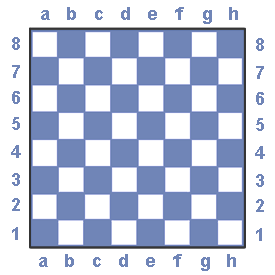
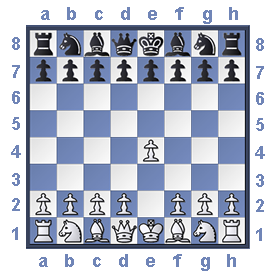
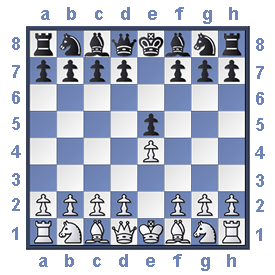
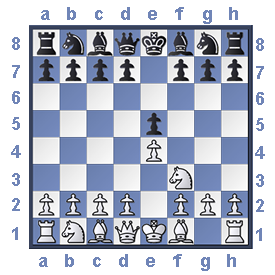


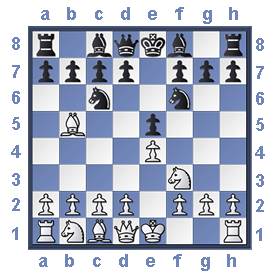


Now lets see how this is written down in algebraic notation. 1.e4 e5 2.Nf3 Nc6 3.Bb5 Nf6 4.0-0 Nxe4. This is a Chess Code!, and it is an easy code to master. All the squares on the Chess Board are numbered and by using these numbers and letters for the pieces we are able to write down the moves.
All the pieces have their special letters as follows;-
K = King
Q= Queen
R= Rook
B= Bishop
N = Knight (if a person prefers he can use Kt also for Knight).
P = Pawn we never really use this letter for the pawn but just the shortened version of the square move. For instance when starting the game if we move the pawn in front of the King one square forward. (see diagram) we could say.....
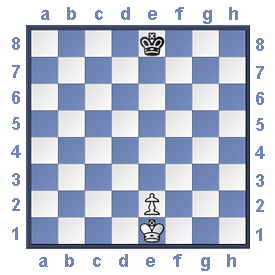
1. e2-e3. The pawn moves from square e2 to e3 this just gets shortened to simply 1. e3. (see diagram)
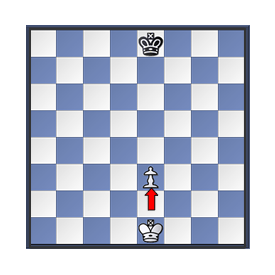
There are a number of other symbols used in algebraic notation as folows;-
x = means takes (i.e. RxP stands for Rook takes Pawn and RxQ stands for Rook takes Queen)
0-0 means Castles on the King's side
0-0-0 means Castles on the Queen's side
These symbols after a move signify;-
e.p -means Pawn takes 'en passant'
+ means check
++ means double check
# means checkmate
! signifies a good move
!! signifies an outstanding move
? signifies a bad move
?? signifies a blunder
!? signifies an interesting move
?! signifies a dubious move.
White: ANDERSSEN
Black: DUFRESNE
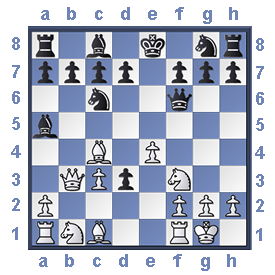 Position after Black's 8th move.......Qf6
Position after Black's 8th move.......Qf6 1. e4
e5
2. Nf3
Nc6
3. Bc4
Bc5
4. b4
Bxb4
5. c3
Ba5
6. d4
ed
7. 0-0
d3
8. Qb3
Qf6
9. e5
Qg6
 Position after Black's 16th move .....Qh5
Position after Black's 16th move .....Qh5 10. Re1
N(g8)e7
11. Ba3
b5
12 . Qxb5
Rb8
13. Qa4
Bb6
14. N(b1)d2
Bb7
15. Ne4
Qf5
16. Bxd3
Qh5
17. Nf6+
gf
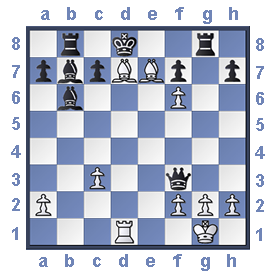 Final Position after White's 24th move Bxe7 #
Final Position after White's 24th move Bxe7 # 18. ef
Rg8
19. R(a)d1
Qxf3
20. Rxe7+
Nxe7
21. Qxd7+
Kxd7
22. Bf5++
Ke8
23. Bd7+
Kd8
24. Bxe7 #
White; NIEMZOWITCH
Black; ALAPIN
 Position after Black's 4th move....Nxd5
Position after Black's 4th move....Nxd5 1. e4
e6
2. d4
d5
3. Nc3
Nf6
4. ed
Nxd5
5. Nf6
c5
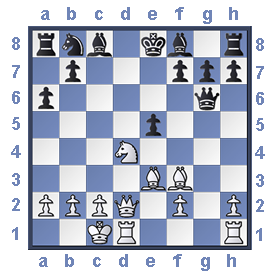 Position after White's 12th move 0-0-0
Position after White's 12th move 0-0-0 6. Nxd5
Qxd5
7. Bd3
cd
8. Nxd4
a6
9. Be2
Qxg7
10. Bf3
Qg6
11. Qd2
e5
12. 0-0-0
ed
13. Bxd4
Nc6
 Position after White's 18th move Re8#
Position after White's 18th move Re8# 14. Bf6
Qxf6
15. R(h) e8+
B-e7
16. Bxc6+
Kf8
17. Qd8+
Bxd8
18. Re8 #








Suppose you are White. The square on which the King starts is called K1, the square in front of it K2, etc.
Here you see the Kings File marked with these numbers. They start on one side at K1 and go along the file ending on the other side of the board at K8.
Similarly the starting square of the Queen is called Q1, the square in front of that Q2 and so on.
So now you see in the diagram both the King's file and the Queen's file marked.
Discriptive Code in Action
Suppose we have a pawn as shown.

We move it one square forward like this.
If we want to say what move has been made we could say 'The Pawn on the King's second square has moved to the King's third square.'
We can write this down simply as P-K3
P means Pawn
-means moves to
K3 means King's third square,

When we record a game we use a shorthand notation to record the movement of the pieces, 'taking' a piece and castling:
| King | K |
| Queen | Q |
| Rook | R |
| Bishop | B |
| Knight | Kt or N |
| Pawn | P |
| 'takes' | x |
for example:
PxP stands for Pawn takes Pawn
RxQ stands for Rook takes Queen
0-0 means 'Castles on the King's side.'
0-0-0 means 'Castles on the Queen's side.'
These symbols or letters after a move signify;-
e.p -means Pawn takes 'en passant'
ch means check
db ch means double check
mate means checkmate
! signifies a good move
!! signifies an outstanding move
? signifies a bad move
?? signifies a blunder
!? signifies an interesting move
?! signifies a dubious move.
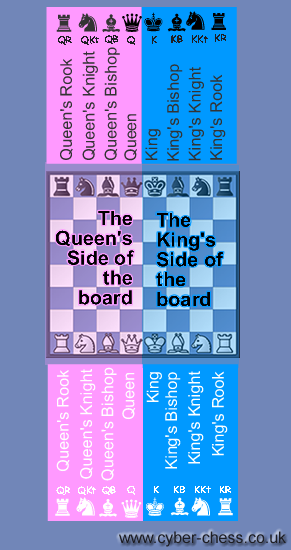 The diagram shows a board set up with just the white and black pieces on their starting squares. All the pawns have been left out for the time being.
The diagram shows a board set up with just the white and black pieces on their starting squares. All the pawns have been left out for the time being.
There are two Rooks, two Bishops, and two Knights. We know that the Rook may be written as -R but we have two Rook-Twins! So how shall we tell them apart?
Remember how we divided the board into two halves? The Queen had half, and the King had half. We shall therefore call the Rook on the King's side of the board- KR(King's Rook), and the Rook on the Queen's side -QR (Queen's Rook).
In the same way we can have-KB (King's Bishop), QB (Queen's Bishop), KKt (King's Knight) and QKt (Queen's Knight).
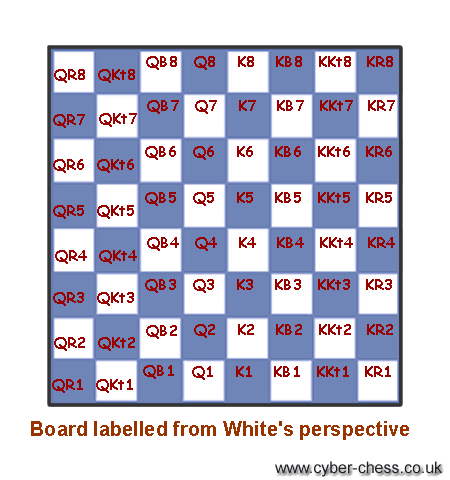 We have shown that each square can have a number from 1 to 8. Here is the board with all the squares labelled as viewed from White's side of the board - viewed from White's persepctive.
We have shown that each square can have a number from 1 to 8. Here is the board with all the squares labelled as viewed from White's side of the board - viewed from White's persepctive. Black must label the Squares from his side of the Board. Unfortunately that means his labels will be upside down from white's perspective!
Black must label the Squares from his side of the Board. Unfortunately that means his labels will be upside down from white's perspective!
Look at the diagram - White's QR8 square is the starting square for Black's Queen's Rook, so Black calls this square his 'QR1'.
 Here is the Board fully labelled from both White and Black's perspective.
Here is the Board fully labelled from both White and Black's perspective.
Note that they both agree on which side of the board belongs to the King or Queen, and they both agree on a square belonging to the King or Queen or a rook or bishop or knight with allegiance to one of the monarchs! The only thing that is different is the number they allocate to the square.
You may also note that when you add black's number to white's number, you always get 9!
Whatever number white allocates to a square, black will allocate a number of 9-(white's number). (Algebra gets everywhere, doesn't it!)
For example:
The square White calls QB2 will be QB(9-2)= QB7 for Black
and the square Black calls KR4 will be KR(9-4) = KR5 for White.
So you see that, unlike in the algebraic notation, each square has two labels - a label from the Black player's perspective and a label from the White player's perspective.
White: ANDERSSEN
Black: DUFRESNE
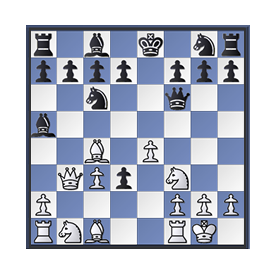 Position after Black's 6th move .......Q-B3.
Position after Black's 6th move .......Q-B3. 1. P-K4
P-K4
2. Kt-KB3
Kt-QB3
3. B-B4
B-B4
4. P-QKt4
BxKtP
5. P-B3
B-R4
6. P-Q4
PxP
7. 0-0
P-Q6
8. QKt3
Q-B3
9. P-K5
Q-Kt3
 Position after Black's 16th move .......Q-R4
Position after Black's 16th move .......Q-R4 10.R-K1
KKt-K2
11. B-R3
P-Kt4
12. QxP
R-Kkt1
13. Q-R4
B-Kt2
14. QKt-Q2
B-Kt2
15. Kt-K4
Q-B4
16.BxQP
Q-R4
17. Kt-B6 ch.
PxKt
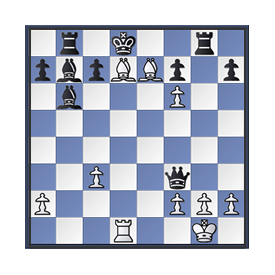 Final Position,after White's 24th move BxKt mate.
Final Position,after White's 24th move BxKt mate.18. PxP
R-Kt1
19. QR-Q1
QxKt
20. RxKt ch.
KtxR
21. QxP ch.
KxQ
22. B-B5ch.
K-K1
23. B-Q7 ch.
K-Q1
24 . BxKt mate.
 Position after Black's 4th move.......KtxP
Position after Black's 4th move.......KtxP 1. P-K4
P-K3
2. P-Q4
P-Q4
3. Kt-QB3
Kt-KB3
4. PxP
KtxP
5. Kt-B3
P-QB4

Position after White's 12th move 0-0-0.
6. KtXKt
QxKt
7. B-K3
PxP
8. KtxP
P-QR3
9. B-K2
QxKtP
10. B-B3
Q-Kt3
11. Q-Q2
P-K4
12 0-0-0
PxKt
13. BxQP
Kt-B3
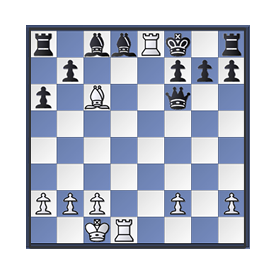
Position after White's 18th move R-K8 mate.
14. B-B6
QxB
15. KR-K1ch
B-K2
16. BxKtch
K-B1
17. Q-Q8ch
BxQ
18. R-K8mate.